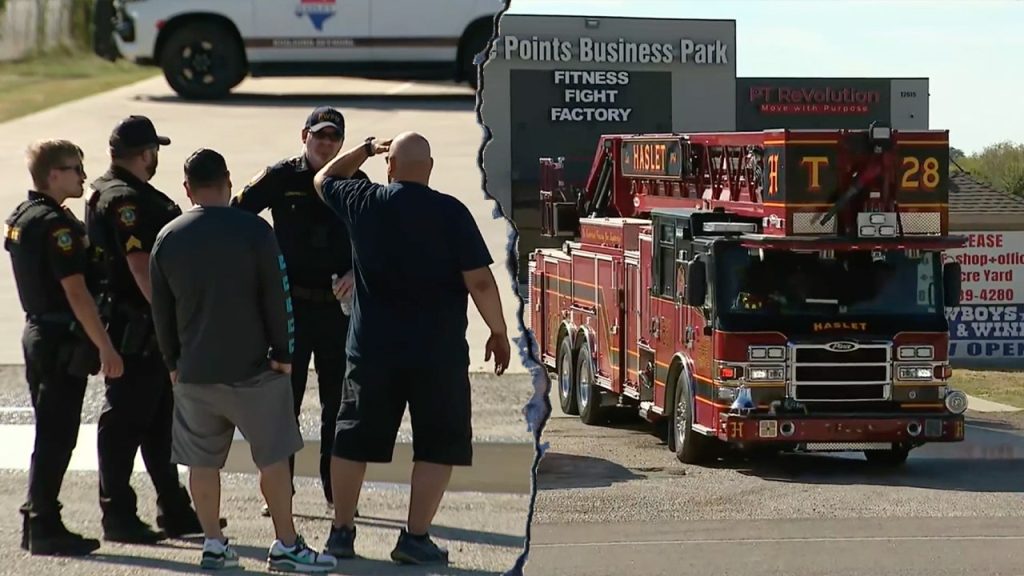Small Plane Crash at Fort Worth’s Hicks Airfield Causes Fire and Road Closures
On a seemingly ordinary Sunday afternoon in Fort Worth, Texas, the peace was shattered when a small aircraft crashed near Hicks Airfield, creating a scene of chaos and concern for local residents and authorities alike. The incident occurred around 1:30 PM in the 12000 block of North Saginaw Boulevard, an area familiar to aviation enthusiasts as the home of a private, member-owned airfield. What makes this crash particularly alarming was not just the aircraft going down, but the fact that it collided with structures on the ground and ignited multiple semi-trucks in flames. The Tarrant County Sheriff’s Office confirmed the basic details while maintaining a measured tone about the developing situation, explaining that “a small aircraft crashed into some unknown structures,” though specific information about casualties or the exact nature of those structures remained unclear in the immediate aftermath.
The response to the emergency was swift and multi-faceted, demonstrating the coordinated efforts typical in aviation disasters. Local fire departments from Fort Worth and Saginaw rushed to the scene to battle the flames engulfing the semi-trucks, while law enforcement established perimeters and controlled traffic in the area. The crash’s impact on the community extended beyond the immediate site as authorities closed both northbound and southbound lanes of Business 287, a major thoroughfare in the area, disrupting weekend travel for many local residents and visitors. Behind the scenes, the wheels of federal investigation were already turning, with both the Federal Aviation Administration (FAA) and the National Transportation Safety Board (NTSB) being notified immediately. The Tarrant County Sheriff’s Office made it clear that while they would provide support with traffic control and other immediate needs, the FAA would take the lead in investigating the cause and circumstances of the crash, as is standard protocol for aviation incidents.
The human element of this story remained frustratingly incomplete in the hours following the crash. Questions about how many souls were aboard the aircraft, their identities, and whether they survived the impact hung in the air like the smoke from the burning wreckage. Similarly, there was no immediate information about potential injuries or casualties on the ground—a critical concern given that the plane crashed into structures and ignited vehicles. These unanswered questions created an atmosphere of anxiety for friends and family of anyone who might have been flying in the area that day, as well as for those who work or live near the crash site. In such moments of uncertainty, communities often come together, waiting for news while hoping for the best possible outcome from such a traumatic event.
Hicks Airfield itself represents a particular type of aviation community that exists throughout America. As a private, member-owned facility, it typically serves recreational pilots, small business aviation, and enthusiasts who share a passion for flight. Such airfields often become tight-knit communities where pilots know each other, share hangar space, and build friendships around their common interest. When tragedy strikes such a community, the impact reverberates through these personal connections, affecting not just those directly involved but an entire network of aviation enthusiasts. The airfield, located north of Fort Worth in Tarrant County, would likely see increased scrutiny in the days following the accident, as investigators work to determine if any factors related to the facility itself might have contributed to the crash.
Aviation incidents like this one highlight the complex interplay of emergency services that must work together seamlessly during a crisis. The Fort Worth Fire Department, Saginaw Fire Department, Fort Worth Police Department, and Haslet Fire Department all responded to the scene, bringing different expertise and resources to bear on the situation. This collaborative approach is essential in addressing the unique challenges posed by aircraft crashes, which can involve hazardous materials, difficult-to-access locations, and complex rescue operations. The fact that multiple semi-trucks caught fire adds another layer of complexity to the emergency response, potentially involving hazardous cargo, fuel spills, and increased risk to first responders. Their professionalism in the face of such dangerous and unpredictable circumstances serves as a reminder of the dedication of emergency personnel who run toward danger while others flee from it.
As the immediate crisis response transitions into investigation and recovery, the community and the aviation world will watch closely for answers about what caused this tragic event. The FAA and NTSB investigations typically involve meticulous examination of wreckage, weather conditions, pilot qualifications, maintenance records, and any communications that occurred before the crash. These investigations can take months to complete but provide crucial insights that often lead to safety improvements across the aviation industry. For the families of those involved and the local community, however, the waiting period can be agonizing as they seek closure and understanding. In the meantime, the incident serves as a somber reminder of the inherent risks of aviation, even as modern aircraft and training make flying safer than ever before. The crash near Hicks Airfield joins the unfortunate list of aviation incidents that prompt us to reflect on these risks while still acknowledging the remarkable safety record that makes such events noteworthy precisely because they are so rare.


